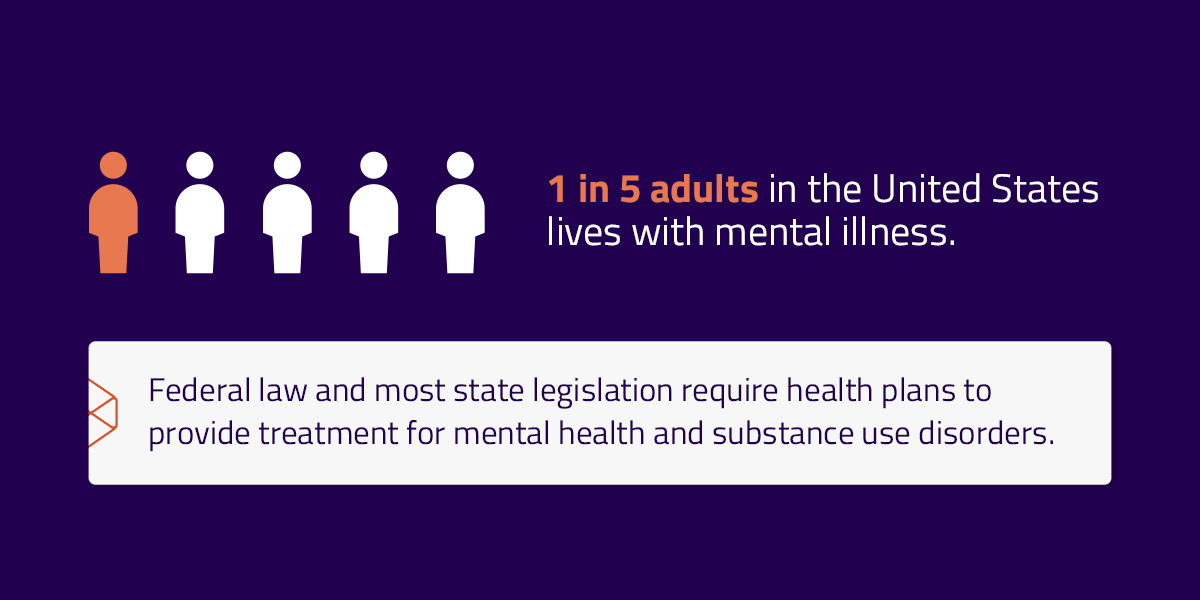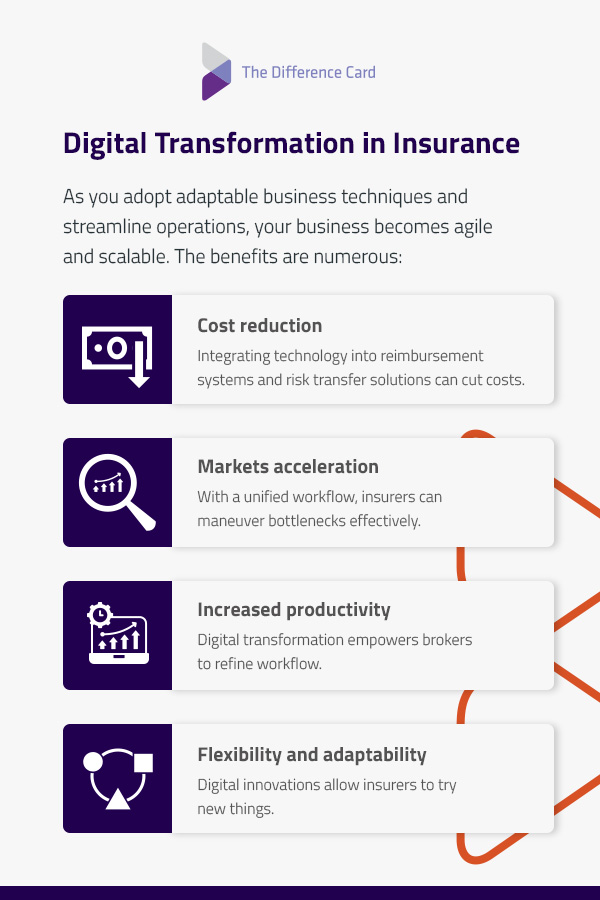
The Broker’s Forecast: Insurance Trends Shaping 2024
Table of Contents
- Key Insurance Trends for Brokers in 2024
- Challenges and Opportunities for Insurance Brokers in 2024
- Digital Transformation in Insurance
- AI and Insurance
- Climate Change and Insurance
- Factors to Consider When Choosing a Growth Partner
- What Is The Difference Card and Why Is It Important?
- Partner With The Difference Card
The insurance industry has evolved over the years. Insurance providers and brokers must know the trends and continuously adjust operations to meet the market demands. Common strategies include adopting technology and expanding services to accommodate customer needs.
While these solutions are generally helpful, brokers must implement strategies to harness their full potential. Producers who want to expand their capabilities must set clear objectives and stay up-to-date with the developments. That way, they can stay ahead of the competition.
Producers use The Difference Card to attract and retain clients by cutting expenses. This innovative strategy drives growth and streamlines regulatory compliance. Learn more about 2024 insurance trends and why The Difference Card has recently gained popularity.
Key Insurance Trends for Brokers in 2024
The insurance industry has witnessed many changes recently. Most of these changes respond to challenges and the need to improve services. In the meantime, brokers and other stakeholders are taking proactive steps to make good use of emerging opportunities:
1. Emergence of Mental Health Coverage
Mental health awareness has increased in the past few years, and for good reason. According to the Centers for Disease Control and Prevention (CDC), 1 in 5 adults in the United States lives with mental illness. Similarly, 1 in 5 youth aged between 13-18 currently have or previously had a serious mental illness. This phenomenon prompted the government and insurers to step in.
Today, federal law and most state legislation require health plans to provide treatment for mental health and substance use disorders. Marketplace plans provide coverage for many conditions, including:
- Mental and behavioral health inpatient services
- Behavioral health treatment like counseling and psychotherapy
- Substance use disorder treatment
Behavioral health benefits vary depending on the state and policyholder's plans. Many brokers extend coverage to provide the mental health support and drive growth in their services.
2. Cybersecurity Awareness in Healthcare
Cybersecurity is crucial in every industry, including insurance. According to IBM, a single data breach in 2023 cost an average of $4.45 million worldwide. This phenomenon is directly linked to adopting digital solutions in commercial settings. While cyber threats and attacks continue, insurers implement various data protection strategies.
On March 5, 2024, the Department of Health and Human Services (HHS) acknowledged a cybersecurity incident involving Change Healthcare, a unit of UnitedHealth Group (UHG). HHS indicated that several medical facilities and other stakeholders had reported cash flow concerns, reflecting the impact of the breach. The department advised affected stakeholders, including Medicare providers, about the flexibility to resolve the issue.
This example and many others demonstrate the collaboration between government agencies and private companies in combatting cyber breaches. The joint efforts are expected to continue and will provide a holistic solution.
3. Adoption of a Customer-First Approach
Customer expectations have evolved significantly over the years. Policyholders demand personalized and easy-to-understand policies that meet their specific needs and preferences. With the rise of digital technologies, most customers envision seamless and convenient interactions. Quality of healthcare services has also become a topic of discussion, alongside transparency in areas such as pricing and coverage details. These occurrences have increased competition in the industry.
To meet these needs, healthcare insurance companies are adopting a customer-first approach. The focus has shifted to delivering exceptional customer experience. Healthcare coverage providers have become transparent and proactive in their communication with customers. They have simplified coverage terms, ensuring that customers are well-informed. Brokers have become supportive, helping clients understand basic requirements before purchasing coverage.
4. Implementation of Digital Solutions
Digital innovations drive Industry 4.0, and organizations use modern technologies to increase their capabilities. Digital transformation streamlines operations and drives growth, especially in uncertain markets. Within the health insurance industry, insurance providers and brokers are leveraging tools like artificial intelligence (AI) and cloud platforms to extend services and products to clients.
Many health insurance providers have developed mobile apps. These platforms enable customers to manage policies, track claims, find healthcare providers, and access health and wellness resources on the go. Most customers also choose insurance providers that cover telemedicine and virtual care, which are critical selling points.
5. Robust Compliance Regimes
Another growing trend in the insurance industry is regulatory compliance. Federal agencies are enhancing oversight over legislation like the Health Insurance Portability and Accountability Act (HIPAA) and Employee Retirement Income Security Act (ERISA) alongside new policy initiatives designed to regulate healthcare-related anti-competitive practices. Other areas, including marketing, underwriting, claims handling and data protection, are also under scrutiny.
Insurance providers and brokers implement strategies to manage risks and build customer trust. As sanctions for non-compliance increase, working with companies that ensure compliance is vital. Traditional insurance brokers are partnering with third-party digital organizations with advanced digital platforms to offer safe and attractive healthcare plans and services.
Challenges and Opportunities for Insurance Brokers in 2024
Regulatory compliance, cybersecurity risks and market volatility are among the most common challenges in healthcare insurance. These roadblocks also offer opportunities to improve services and drive growth:
- Regulatory compliance: Brokers must proactively navigate regulatory challenges while adapting to new market conditions. Partnering with insurtech companies is a practical strategy. It allows you to expand your offerings and improve operational efficiency without compromising compliance.
- Cybersecurity risks: Insurance providers must implement robust data protection protocols to mitigate security breaches. They must also collaborate with third-party organizations with strong cybersecurity systems. This strategy ensures optimal protection and builds client trust.
- Market volatility: Brokers must remain agile to withstand economic uncertainty. You can achieve this with digital tools to address your pressing needs. Investing in digital platforms can eliminate bottlenecks and save money.
Digital Transformation in Insurance
Digital transformation means incorporating digital technologies into your services and processes. As you adopt adaptable business techniques and streamline operations, your business becomes agile and scalable. The benefits are numerous:
- Cost reduction: Integrating technology into reimbursement systems and risk transfer solutions can cut costs. It eliminates redundant tasks and errors, which may require time and effort to resolve.
- Markets acceleration: With a unified workflow, insurers can maneuver bottlenecks effectively. Technology can help them respond effectively to market demands and emerging trends, letting them stay ahead of the competition.
- Increased productivity: Digital transformation empowers brokers to refine workflow. This strategy can enhance productivity and improve customer satisfaction.
- Flexibility and adaptability: Digital innovations allow insurers to try new things. Brokers can adapt to various situations and expand their capabilities by forming new partnerships or investing in modern technology.
It's also vital to integrate technologies strategically to harness their full potential. Brokers must implement digital transformation by following industry best practices. Consider these helpful guidelines:
- Business objectives: Your digital transformation goals must align with your business needs. Define your objectives and the outcomes you aim to achieve.
- Stakeholder engagement: Involve stakeholders to gather ideas and ensure a smooth transition. Getting and addressing feedback is an excellent way to learn if your processes are working.
- Regulatory compliance: The healthcare and insurance industries are highly regulated, so make sure your digital initiatives comply with the relevant laws.
- Data security and privacy: Ensure the data handling practices adhere to industry standards. The same applies to all other companies you work with.
- Interoperability: Check that digital systems and platforms are interoperable with the existing IT infrastructure. Seamless data exchange is essential for providing integrated services.
- Change management: Provide adequate training and support to help the team adapt to the new digital tools and workflows. Change management can facilitate a smooth transition and minimize resistance.
- Customer experience: Prioritize user experience by developing an intuitive, user-friendly and accessible platform. Client satisfaction is a big part of digital transformation.
AI and Insurance
Like in other industries, AI has expanded healthcare insurance services and products. Brokers use these tools for three main reasons:
- Improve experience: Insurers and brokers leverage AI tools to enhance the experience for customers and staff. Customers can use chatbots to get quick answers, and agents and workers can use AI platforms to streamline workflow.
- Highten productivity: AI tools can perform mundane tasks accurately and efficiently. Automating processes can increase operational efficiency.
- Mitigate risks and manage compliance: Automating functions such as compliance monitoring and fraud detection can enhance compliance and mitigate risks.
There are many use cases of AI in health insurance. Insurers and brokers can employ different AI types in operations, such as:
- Staff assistance: AI models can perform underwriting, claims processing, pricing and quote generation, and other policy-related functions.
- Customer support: AI models can provide digital support to clients across all engagement points.
- Fraud detection: AI algorithms can detect patterns of fraudulent behavior to help mitigate financial losses and other related issues.
- Decision-making: AI models can generate insights from large datasets to augment decision-making in areas like portfolio steering.
The AI and machine learning (ML) technology will continue to evolve. At the same time, insurance regulators will likely introduce new legislation and tighten the existing landscape.
Climate Change and Insurance
The U.S. government has developed several programs to tackle climate crises. These initiatives reflect the ongoing challenges, such as natural disasters and disease transmission. Many people expect changes in the regulatory landscape in the coming years. Furthermore, most customers will likely align themselves with insurers interested in sustainability. Unsurprisingly, insurers are leveraging internal resources and independent expertise to meet environmental, sustainability and governance (ESG) standards.
Insurers worldwide are providing climate-specific coverage to meet market demands. For example, Japanese insurance companies started selling heatstroke insurance plans in 2022 to address the increase in extreme heat events in the region. Also, considering the impact of climate change on mental health, insurance providers are expanding coverage to accommodate those needs.
Adapting to the changing environment is an opportunity for insurers to drive growth. Developing innovative solutions to tackle the challenges allows you to expand your offerings while helping clients live healthier lives. Financial considerations are crucial in insurance. However, the social aspect has gained momentum in recent times.
Factors to Consider When Choosing a Growth Partner
Insurance producers often collaborate with third-party organizations for various purposes. While the considerations may differ depending on the services, some general guidelines apply in most situations. Here are eight key factors to consider:
- Reputation: Evaluate the reputation and track record of the service provider. Look for reviews, testimonials and references to gauge their reliability and performance.
- Experience: Assess the provider's expertise in the industry and their services. Then, consider their experience working with insurance brokers.
- Compliance and security: Verify that the service provider complies with relevant regulations and industry standards. Ensure they have robust systems to protect sensitive information.
- Scalability and flexibility: Determine if the provider can scale its services to meet your evolving needs. Some things to consider are the personalization options, system integration and adaptability.
- Cultural fit: Consider the cultural fit between your organization and the service provider. It's best to choose a company with values that align with yours.
- Value: Before deciding, assess the value propositions different service providers offer. Focus on the return on investment (ROI) instead of choosing the most affordable alternative.
- Customer support: Evaluate the provider's customer support services, availability and responsiveness. Ensure they have a dedicated support team to address your issues promptly.
- Technology and innovation: Assess the provider's technology stack tools and capabilities. Look for innovations that can drive efficiency and competitive advantage.
What Is The Difference Card and Why Is It Important?
The Difference Card works with medical insurance plans to cut expenses. It's an exclusive distribution strategy that gives producers unique health insurance savings solutions to offer clients. Your clients can customize their benefit plans according to their needs, lowering spending by 18% on average. Since its founding in 2001, The Difference Card has provided about $1.5 billion in savings.
The Difference Card is the ideal partnership for insurance agencies searching for growth opportunities. In 2023, producer partners using The Difference Card won 117 new accounts, achieving $5.1 million in new revenue. The Difference Card attracts new clients and helps retain existing customers.
The Difference Card partners with best-in-class brokerage firms and is committed to helping brokers select the best plan designs for their clients. In addition to the financial gains, The Difference Card provides ERISA compliance services. Brokers can use this service to support clients and help them avoid costly penalties. The offerings include unlimited plan documents, restatements, amendments and non-discrimination testing.
Partner With The Difference Card
The healthcare insurance industry grows daily. With the evolution of digital technologies and phenomena like climate change, brokers must develop strategies to make their businesses agile and scalable. Additionally, it's crucial to ensure regulatory compliance to avoid costly penalties.
Insurance providers can expand their capabilities by partnering with third parties like The Difference Card. The Difference Card offers cost-saving benefits to clients and assists with regulatory compliance. Since its inception, the company has revolutionized the healthcare insurance industry with innovative solutions.
We have years of experience supporting businesses and can help you drive growth. Leverage our impressive services to attract and retain clients. We are ready to form a long-lasting relationship and look forward to hearing from you. Request a proposal today!




